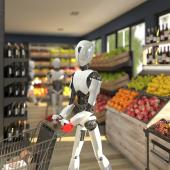Adaptability Is Key to Survival in the Age of Digital Darwinism
Charles Darwin said in On the Origin of the Species that it’s not the strongest or most intelligent of the species that survives, but the one that’s most adaptable to change.
While we’re a long way off from 1859, the idea is just as relevant as it ever was. We are a species whose habitat is now ruled by technology, and it is chancing at a rapid pace.
Connectivity, data analytics, artificial intelligence, and the Internet of Things are rapidly changing our world and environment, and according to Moore’s Law, the pace of change will only grow. IBM said in a recent report that 90 percent of the world’s data has been generated in the past two years. Much as we couldn’t have envisioned 2018 in the year 2000, we can’t quite know what our habitat will be like in 2025 or 2035.
Technological change has brought tremendous opportunity for innovative organizations, but it is also driving to extinction companies that fail to adapt. Credit Suisse analysts wrote in a note to investors in August the average age of a company in the S&P 500 has fallen from 60 years in the 1950s to less than twenty years now. It is not the biggest or more financially stable that will survive, but the ones who manage to adapt to the exponentially accelerating pace of change.
Disruption isn’t new, but the speed, complexity and global nature of it is at a scale we’ve never seen before. Technology is also expanding the competitive marketplace to a global level where even small businesses and workers compete digitally across borders and with no limits.
In a game where the rules and goals are constantly changing, the long-term winners aren’t those that simply try to make it to the next level but the ones that continually adapt.
Companies that don’t have a high level of adaptability will fade away through dissolution or M&A. Blockbuster didn’t adapt to the shift to digital media. Kodak didn’t adapt to shift from film to digital. Borders didn’t adapt to digital bookselling. And Sears, which first incorporated in 1892 and had been a bedrock department store for more than a century, quickly became irrelevant when it failed to adapt to omnichannel retail and changing consumer preferences.
Meanwhile, organizations and entrepreneurs that have embraced change and adaptability have been able to capitalize on it. Netflix, Uber, Airbnb, Apple, Amazon, and Google, are all perfect examples of how what’s obscure today could be ubiquitous and necessary tomorrow.
Companies need to approach the idea of adaptability with structure, strategy, technology and culture to continually respond to the changing circumstances and the environment.
If this pace of change is scary for organizations and the C-suite, it’s even more frightening for workers. We can no longer use the same assumptions, and many of our traditional behaviors have become outdated. Many workers focus on cultivating their emotional intelligence to learn more about their own emotions and the emotions of others. It’s certainly important in today’s environment, but Adaptability Quotient (AQ) will soon become the primary predictor of success, ahead of both general intelligence and emotional intelligence.
The focus on adaptability isn’t new to innovators and digital pioneers. Some of the most successful people over the past two to three decades have been those that have adapted to take advantage of the changing environment. An article in Harvard Business Review in 2011 called adaptability the “new competitive advantage” and noted that traditional approaches to strategy don’t always work because they assume a predictable and stable environment.
Like organizations, humans will also face obsolescence if they fail to adapt. A report by the McKinsey Global Institute found technology will eliminate roughly of the U.S. workforce in the coming decade. It noted that by 2030, up to 14 percent of the global workforce (375 million workers) may need to switch occupational categories. And all workers will need to adapt as their occupations evolved along “increasingly capable machines,” McKinsey said. Regardless of their role, almost all workers will need to seek higher educational attainment and spend more time on activities that require social and emotional skills, creativity, cognitive capabilities and other skills that can’t as easily be automated. The talk about Artificial Intelligence, Machine Learning, Robotic Process Automation is scaring many, but exciting just a few. It has replaced blue-collar workers and will soon replace white-collar – those who embrace it and adapt will prevail.
Those who ultimately survive in the coming years will be those who embrace change and have the willingness and enthusiasm to adapt. They will be the ones seeking new skills, learning new trades, acquiring new knowledge about technologies we barely yet know exist. Pick virtually any major or field and there is a strong likelihood that it will experience major disruption in the coming years. Moving from a fixed mindset to a growth mindset will help us see problems as opportunities and embrace them as learning experiences. This eventually has to get back to our core educational system, for which most graduate degrees will no longer be relevant after just a few years.
McKinsey noted that even with the displacement the efficiency and increased productivity generated by automation would create new roles and opportunities, much as technologies of the past have done.
In nature, all organisms must be able to adapt to their habitat to survive. This means changing their body or behavior to survive changing climate, predators or other species that compete for the same food or space. But unlike species that naturally adapt over the span of multiple generations or centuries, we have little time and must actively and continually adjust our core mindset and culture to embrace adaptability as an individual, organizational, and societal level.



